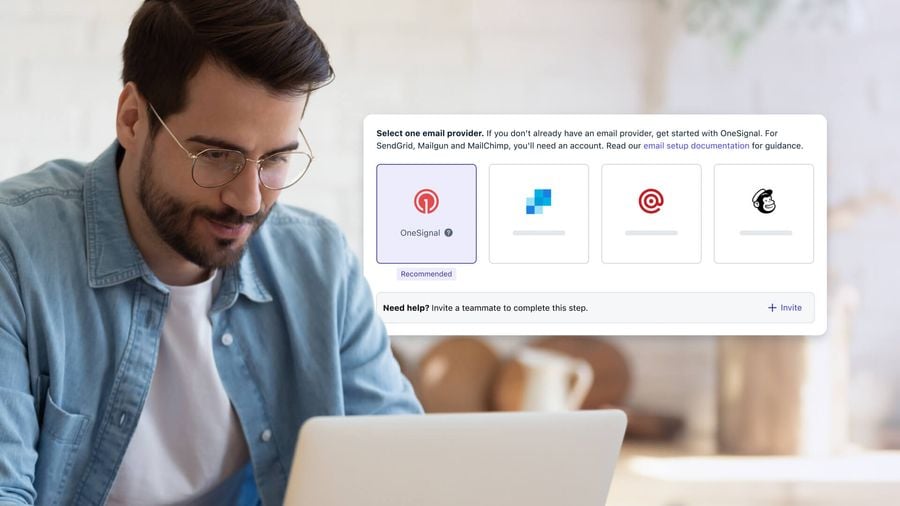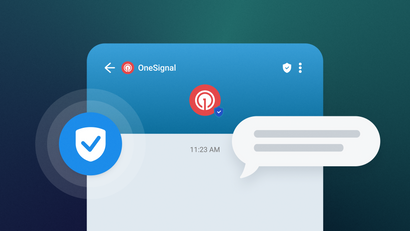Email is a veteran channel. Unlike channels like push notifications and SMS, email has been around for half a century! As such, the email ecosystem has had ample time to mature and evolve. Today, there are a wide range of modern Email Service Providers (ESPs) to choose from. Choosing an ESP is important because it can either enhance or compromise your email marketing program.
What is an ESP?
An ESP, not to be confused with an ISP (internet service provider), is an email service provider. An ESP is a business that hosts email services and software on independent servers. The best email service providers are a one-stop shop for clients, empowering businesses to send newsletters, distribute surveys, send bulk emails, and more.
Do I Really Need One?
The short answer is yes. If you plan on emailing customers at scale, you need a provider to keep your customer data secure and remain compliant with laws and regulations, at the very minimum. But the right ESP will do more than that — it will meet your business’s unique needs and make your marketing efforts more successful. You’ll want to choose the most appropriate ESP for your business size and functions in order to minimize the time it takes to set up your campaigns, streamline your day-to-day operations, and optimize email campaign performance. With the right ESP, you’ll see savings from major productivity improvements.
What are the benefits of using an ESP?
The right ESP can provide a variety of benefits for you, whether you're a small business or a large enterprise.
Drive Greater ROI
For every dollar spent on email, businesses see an average ROI of $36, which represents a return of almost 4,000 percent!
Boost Acquisition and Retention
One study shows that 81 percent of small and medium-sized businesses rely on email for customer acquisition and 80 percent use email marketing to retain customers.
Easily Manage Contacts and Audience Preferences
An ESP allows you to manage lists, collect contacts, and evaluate and optimize email campaigns. Some email marketing software are part of an omnichannel solution. Integrating your ESP with other channels allows you to track these contacts and their behaviors across other channels, such as push notifications, in-app, and SMS.
Stay Compliant with Email Laws and Regulations
ESPs also help you stay compliant with international email privacy laws, like CAN-SPAM. If you don’t comply with these privacy regulations, your business can suffer steep fines.
Support Authentication and Security
ESPs help authenticate your emails and protect your email lists from being stolen or hacked. Some ESPs support authentication standards, such as DMARC, SPF, and DKIM.
What to Consider When Choosing a Good ESP
Here are some tips and basic steps for choosing the best ESP for your company.
Be Mindful of Your Main Use Cases
Think about the main types of emails you'll be sending. Are you sending mostly transactional or marketing messages? Are you hoping to send newsletters, dynamic content, drip campaigns, promotional emails, email onboarding sequences, or all of the above? Some ESPs will be better than others for different use cases, whether you're communicating to potential customers or existing ones.
Think About Your Contact List Size
The best ESP for you will depend on the number of contacts you’re sending content to. Often, small businesses with smaller subscriber lists will opt to use providers with a streamlined customer experience, simpler functionality, and a more streamlined feature set. Larger enterprises with huge contact lists and a variety of use cases may opt for enterprise-level ESPs with more advanced features and complex functionality. In addition to contact list size, you should consider your email send volume (a.k.a. the number of emails you plan to send). This becomes a budgetary consideration because some providers charge based on CPMs (Cost Per Mile), or the cost of sending a thousand email messages, while others charge on a subscription basis.
Review Data and Privacy Policies
ESPs store your customers' data, which means data security should be top-of-mind. The last thing you want is for sensitive information to be compromised while en route to its recipient. Consider whether a given ESP meets your security requirements by checking out their data privacy and compliance pages.
Your security needs will also depend on your vertical. If you’re in the healthcare industry, you may need to be HIPAA compliant, for instance.
Consider the types of safeguards a given ESP has for maintaining security, such as firewalls, password policies, and encryption practices. You may also want to think about how accessible your data is, how quickly the database updates, and the given provider’s data storage limitations and costs.
Compare Costs
If you’re on the search for an email provider today, you’re likely aware of the tremendous ROI this medium can have for your business. However, it’s still important to factor cost into your decision. ESPs tend to charge based on send volume or on a subscription basis. Factors that go into the overall cost of this channel include license costs, usage rates, and overage costs. You should also evaluate what a given ESP charges for add-ons.
Are there sporadic billings customers should expect? Also, evaluate your budget based on how much you plan to grow. How much do you plan to grow your send volume and subscriber list over time? If you’re hoping to scale, flexible payment terms and progressive feature access could be useful for your email use case.
Keep in mind that some high-end marketing email providers can get expensive. One million subscribers could cost you $50K+ per year. Transactional email companies are a fraction of the price, but their features may be more limited. Think about what’s best in terms of your use case.
Compare Features
When doing a side-by-side analysis of email providers, think about what capabilities on your wish list are must-haves.
Below are some key email features that good ESPs offer that can help you optimize and scale your engagement strategy:
✅ Deliverability: Ensuring your emails reach your recipients' inboxes is paramount. Look for ESPs with a strong track record of high deliverability rates and a good sender reputation. Find out what factors impact email deliverability.
✅ Email List Management: An ESP should provide tools for managing your email lists, including segmentation, list cleaning, and list growth strategies. Effective list management helps you send targeted and relevant content to your subscribers.
✅ Preference Centers: If you're operating a multichannel engagement strategy, user preference centers are a great way to earn opt-in permission and empower users to control their communication preferences across channels.
✅ Email Templates and Design Tools: Look for a platform that offers customizable email templates and an intuitive drag-and-drop editor for creating visually appealing emails without the need for extensive coding skills.
✅ Automation and Personalization: ESPs should support automation workflows that allow you to send triggered emails, drip campaigns, and personalized content based on user behavior and preferences.
✅ Reporting and Analytics: Comprehensive reporting tools are essential for tracking the performance of your email campaigns. Look for ESPs that provide insights into open rates, click-through rates, conversion rates, and more.
✅ Integration with Other Tools: Ensure that the ESP can integrate with your existing software, such as CRM systems, e-commerce platforms, and analytics tools. This will help streamline your email marketing efforts.
✅ Scalability: Choose an ESP that can grow with your business. It should be able to handle an increasing number of subscribers and email volume as your company expands — without breaking your budget. As you think about scalability, it's worth estimating how much you'll pay as your subscriber base grows and your email strategy becomes more complex. Weigh these costs against your revenue targets and the ROI of your email marketing efforts.
✅ A/B testing: The ability to conduct A/B tests on subject lines, content, and other elements of your emails is essential for optimizing your campaigns over time.
✅ Mobile Responsiveness: Given the prevalence of mobile device usage, it's crucial that your emails are mobile-friendly and that the ESP supports responsive design.
✅ Security and Compliance: Ensure the ESP follows best practices for data security and complies with email marketing regulations such as GDPR and CAN-SPAM Act.
✅ Customer Support: Evaluate the level of customer support and training provided by the ESP. You'll want a provider that offers reliable support when you encounter issues or have questions.
✅ Pricing and Cost Structure: Compare pricing plans and make sure the ESP's cost structure aligns with your budget and anticipated email marketing needs.
✅ Deliverability Tools: Look for features like spam testing, authentication protocols (DKIM, SPF, DMARC), and bounce handling to improve your email deliverability.
✅ API and Developer Support: If you have more complex integration requirements, ensure that the ESP offers a robust API and documentation for developers.
✅ Multichannel Capabilities: Depending on your marketing strategy, you might also consider ESPs that support other communication channels like SMS, push notifications, and social media. Before you get set up with a provider, consider your long-term goals and assess the risks associated with siloing your email software from other channels.
✅ User Interface and Ease of Use: The ESP's user interface should be intuitive, making it easy for your team to create and manage email campaigns efficiently. To ensure marketing and product teams can move quickly without technical support, look for a low-code/no-code solution.
✅ Customization and Branding: Some ESPs offer white-label solutions, allowing you to customize the platform with your branding, which can be important for agencies or businesses with multiple brands. Maintaining a consistent brand experience across email campaigns and other platforms is also important, so it helps to find an email provider that makes it easy to seamlessly incorporate your brand colors, logo, headers, footers, and design elements into messages.
✅ Data and List Segmentation: The ability to segment your email list based on various criteria, such as demographics, behavior, and engagement, is crucial for sending relevant content. Learn more about email segmentation best practices.
✅ Subscription Prompts: Some providers like OneSignal offer pre-built web prompts to help you grow your subscriber list.
By considering these features and conducting thorough research, you can find an Email Service Provider that aligns with your company's specific needs and goals. It's often helpful to start with a clear understanding of your objectives and a list of must-have features to guide your selection process.
Don't Overlook the Benefits of a Consolidated Platform
If you’re managing multiple channels as an app marketer, managing your messaging campaigns and data in one platform can streamline your workflow, be more cost-efficient, promote greater collaboration between channel owners, reduce the risk of over-messaging, and ultimately help you deliver a better UX. Omnichannel engagement solutions like OneSignal will let you send from a single dashboard and API.
The most effective providers will provide a means to auto-tag and segment your target audience across channels based on real-time behavior. Automating these processes will help ensure that your subscriber lists remain clean regardless of where the touchpoint occurs and will empower you to deliver more personalized experiences as you scale without adding to your workload.
OneSignal's Data Tags feature helps you automatically tag and segment users based on their in-app behavior or engagement with your campaigns. This real-time segmentation will empower you to better guide your users through each touchpoint along your customer journey.
Consider Time-to-Value and Learning Curve Friction
How easy is a given software to implement and get results from? How much technical support is needed? Take a look at the time and resources you’ll need to get up and running with a given ESP and land emails in your subscribers' inboxes. Do some research on how much their support team is available for migration and what API implementation might look like.
Along with ease of implementation, you should also evaluate the size and bandwidth of your email team and the time you have to invest in learning your email provider's abilities. Ease of use may be a higher priority for you if your team has limited time to spend learning the platform.
In addition, you’ll want to consider how much technical support you have for your email design and execution. The right email service provider will have more robust features for non-technical users such as email message builders and a single place to view data.
Check Out Customer Support, Documentation, and Reviews
No matter how intuitive a platform is, you're bound to need support at some point in time, and it's vital that you can rely on your provider to provide it in an efficient manner. When comparing options, read customer reviews to uncover the quality of support offered, and the average support ticket turnaround time. In addition, check out their documentation, resources, and guides to see if you can easily troubleshoot issues with the company’s available resources.
Why Choose OneSignal?
With OneSignal, your brand can get your mailing list's attention, send dynamic email campaigns, and manage your cross-channel conversations from one intuitive platform. We partner with best-in-class ESPs, including SendGrid, Mailgun, and Mailchimp to offer seamless email marketing automation alongside every engagement channel you need. Learn more about how to drive results with OneSignal email, and reach out to us to get started today!
Talk to an Email Expert



